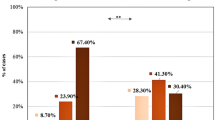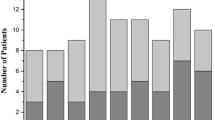Abstract
In this study, we measured serially the serum levels of cytokines including interleukin-6 (IL-6), IL-8, soluble IL-2 receptor (sIL-2R) and tumour necrosis factor α (TNF-α) in 60 patients with Kawasaki disease (KD) and evaluated the clinical significance of these cytokines in predicting coronary aneurysm formation. Of the 60 patients, 12 were complicated with coronary aneurysm. Blood samples were collected within the 1st week after onset of fever, then once a week for the 1st month, and once a month for another 5 months. The serum levels of IL-6, IL-8, sIL-2R and TNFα were measured using an ELISA or RIA method. Our results show that the changes in serum IL-6 and IL-8 were faster than those of sIL-2R and TNFα. Within the 1st week, the serum levels of IL-6 and IL-8 were significantly higher in the patients with than in those without coronary aneurysm (P<0.001). In addition, the serum levels of IL-6 and IL-8 obtained in the 1st week were highly correlated (P<0.001) with those of C-reactive protein and erythrocyte sedimentation rate, and the serum levels of sIL-2R and TNFα were also increased at the 1st week reaching the highest level in the 2nd week. In the 2nd week, the serum levels of sIL-2R and TNFα were significantly higher in the patients with than in those without coronary aneurysm (P<0.05). These findings suggest that the serum levels of IL-6 and IL-8 obtained in the 1st week may serve as useful parameters in predicting coronary aneurysm formation in KD patients.
Similar content being viewed by others
Abbreviations
- KD:
-
Kawasaki disease
- IL:
-
interleukin
- TNF-α:
-
tumour necrosis factor α
- IFN-r:
-
interferon-r
- sIL-2R:
-
soluble interleukin-2 receptor
- PMN:
-
polymorphonuclear leucocytes
References
Baggiolini M, Walz A, Kunkel SL (1989) Neutrophil activating peptide-1/interleukin-8, a novel cytokine that activates neutrophils. J Clin Invest 84:1045–1047
Beutler B, Cerami A (1986) Cachectin and tumor necrosis factor as two sides of the same biological coin. Nature 320:584–588
Gauldie J, Richards C, Harnish D, Lansdorp P, Baumann H (1987) Interferon beta 2/B cell stimulatory factor type 2 shars identify with monocyte-derived hepatocytestimulatory factor and regulates the major acute phase protein response in liver cells. Proc Natl Acad Sci USA 84:7251–7255
Japan Kawasaki Disease Reseach Committee (1984) Diagnostic guideline of Kawasaki disease, 4th edn. Tokyo, Japan, Kawasaki Disease Research Committee
Kawasaki T (1969) Mucocutaneous lymph node syndrome-clinical observation of 50 cases. Jpn J Allergol 16:178–222
Kawasaki T (1989) Kawasaki disease. Asian Med J 32:497–506
Larsen CG, Anderson AO, Appella E, Oppenheim JJ, Matsushima K (1989) The neutrophil-activating protein (NAP-1) in also chemotactic for T lymphcoytes. Science 243:1464
Leung DYM (1991) Immunologic aspects of Kawasaki disease: Implications for pathogenesis and therapy. Clin Cardiol 14 [Suppl II]: II-11–5
Leung DYM, Geha RS, Newburger JW, Burns JC, Fiers W, Lapierre LA, Pober JS (1986) Two monokines, interleukin-1 and tumor neucrosis factor, render cultured vascular endothelial cells susceptible to lysis by antibodies circulating during kawasaki syndrome. J Exp Med 164:1958–1972
Leung DYM, Cotran RS, Kurt-Jones E, Burns JC, Newburger JW, Pober JS (1989) Endothelial cell activation and high interleukin-1 secretion in the pathogenesis of acute kawasaki disease. Lancet II:1298–1302
Lin CY, Hwang B (1987) Serial immunologic studies in patients with mucocutaneous lymph node syndrome (Kawasaki disease). Ann Allergy 59:291–297
Lin CY, Hwang B, Chiang BN (1986) High risk factors in the development of coronary aneurysms in patients with mucocutaneous lymph node syndrome (Kawasaki disease). Acta Cardiol Sinica 2:253–262
Lin CY, Lin CC, Hwang B, Chiang BN (1991) The changes of interleukin-2, tumor necrotic factor and gamma-interferon production among patients with kawasaki disease. Eur J Pediatr 150:179–182
Mantovani A, Dejana E (1989) Cytokines as communication signals between leukocytes and endothelial cells. Immunol Today 10:370–374
Maury CPJ, Salo E, Pelkonen P (1989) Elevated circulating tumor necrosis factor α in patients with kawasaki disease. J Lab Clin Med 113:651–654
Melish ME, Hicks RV (1990) Kawasaki syndrome: Clinical features, pathophysiology, etiology and therapy. J Rheumatol 17:2–10
Rubin LA, Jay G, Nelson DL (1986) The released interleukin-2 receptor binds interleukin-2 efficiently. J Immunol 137:3841–3849
Wolp ESD, Cerami A (1989) Macrophage inflammatory proteins 1 and 2: members of a novel superfamily of cytokines. FASEB JH 3:2565–2753
Ueno Y, Takano N, Kanegane H, Yokoi T, Yachie A, Miyawaki T, Tamiguchi N (1989) The acute phase nature of interleukin 6: studies in kawasaki disease and other febrile illness. Clin Exp Immunol 76:337–342
Author information
Authors and Affiliations
Rights and permissions
About this article
Cite this article
Lin, C.Y., Lin, C.C., Hwang, B. et al. Cytokines predict coronary aneurysm formation in Kawasaki disease patients. Eur J Pediatr 152, 309–312 (1993). https://doi.org/10.1007/BF01956740
Received:
Accepted:
Issue Date:
DOI: https://doi.org/10.1007/BF01956740




